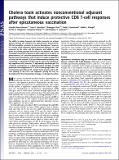Cholera toxin activates nonconventional adjuvant pathways that induce protective CD8 T-cell responses after epicutaneous vaccination
Author(s)
Olvera-Gomez, Irlanda; Hamilton, Sara E.; Xiao, Zhengguo; Guimaraes, Carla P.; Ploegh, Hidde; Hogquist, Kristin A.; Wang, Liangchun; Jameson, Stephen C.; ... Show more Show less
DownloadOlvera-Gomez-2012-Cholera toxin activa.pdf (431.5Kb)
PUBLISHER_POLICY
Publisher Policy
Article is made available in accordance with the publisher's policy and may be subject to US copyright law. Please refer to the publisher's site for terms of use.
Terms of use
Metadata
Show full item recordAbstract
The ability to induce humoral and cellular immunity via antigen delivery through the unbroken skin (epicutaneous immunization, EPI) has immediate relevance for vaccine development. However, it is unclear which adjuvants induce protective memory CD8 T-cell responses by this route, and the molecular and cellular requirements for priming through intact skin are not defined. We report that cholera toxin (CT) is superior to other adjuvants in its ability to prime memory CD8 T cells that control bacterial and viral challenges. Epicutaneous immunization with CT does not require engagement of classic toll-like receptor (TLR) and inflammasome pathways and, surprisingly, is independent of skin langerin-expressing cells (including Langerhans cells). However, CT adjuvanticity required type-I IFN sensitivity, participation of a Batf3-dependent dendritic cell (DC) population and engagement of CT with suitable gangliosides. Chemoenzymatic generation of CT–antigen fusion proteins led to efficient priming of the CD8 T-cell responses, paving the way for development of this immunization strategy as a therapeutic option.
Date issued
2012-01Department
Massachusetts Institute of Technology. Department of Biology; Whitehead Institute for Biomedical ResearchJournal
Proceedings of the National Academy of Sciences
Publisher
National Academy of Sciences
Citation
Olvera-Gomez, I. et al. “Cholera Toxin Activates Nonconventional Adjuvant Pathways That Induce Protective CD8 T-cell Responses After Epicutaneous Vaccination.” Proceedings of the National Academy of Sciences 109.6 (2012): 2072–2077. Copyright ©2012 by the National Academy of Sciences
Version: Final published version
ISSN
0027-8424
1091-6490